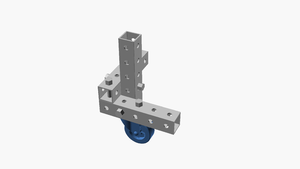Caster joints: Difference between revisions
From
No edit summary |
No edit summary |
||
| Line 9: | Line 9: | ||
=Introduction= | =Introduction= | ||
Casters are one of the most widely used [[parts]] and come in many shapes and sizes, often with a 4-hole mounting plate. | |||
=Challenges= | =Challenges= | ||
Mounting the caster securely through all four mounting holes near a tri-joint (which tend to be at the corners of projects, exactly where casters want to be) isn't easily accomplished. | |||
=Approaches= | =Approaches= | ||
| Line 17: | Line 19: | ||
Caster-joint-suboptimal.scad.png|link=[[Caster joints]]|Suboptimal caster joint | Caster-joint-suboptimal.scad.png|link=[[Caster joints]]|Suboptimal caster joint | ||
</gallery> | </gallery> | ||
One corner configuration secures the caster at two points and centers the vertical frame member on the caster. The other applies significant force, with the possibility of a bending moment on the caster mounting plate. | |||
=References= | =References= | ||
Revision as of 01:22, 3 April 2021
Technique: Caster joints
| Tools: | Wrenches |
|---|---|
| Parts: | Frames, Bolts, Nuts, End caps, Casters |
| Techniques: | Bolting, Tri joints, Shelf joints |
Introduction
Casters are one of the most widely used parts and come in many shapes and sizes, often with a 4-hole mounting plate.
Challenges
Mounting the caster securely through all four mounting holes near a tri-joint (which tend to be at the corners of projects, exactly where casters want to be) isn't easily accomplished.
Approaches
-
Suboptimal caster joint
One corner configuration secures the caster at two points and centers the vertical frame member on the caster. The other applies significant force, with the possibility of a bending moment on the caster mounting plate.


